The House of NLP
Gabriel R. Suciu, Romania
Gabriel R. Suciu is a sociologist. He is interested in NLP and creativity. He has written two books – “Erving Goffman and the Organizing Theories” (2010) and “Introduction to Neuro-Linguistic Programming” (2015) – and some articles, like: “Multiple Intelligences” (2011). E-mail: gabriel_remus_suciu@yahoo.com, gabriel.suciu@ymail.com
Menu
The house of the child
The house of NLP
Documents about two floors of the house of NLP
Controversies on the six levels of the palace-cottage
The labyrinths of the palace-cottage
Conclusion
References
Many children draw houses, dreaming with the pencil or the brush in their hands. Anyone who was a child and had in front of his/ her eyes a sheet of paper, some crayons, or some watercolors and a brush can testify for this fact. And for a child, the house is probably the most spontaneous and deeper dream.
The expert eye of a teacher could discover what kind of life was living the child by the way he/ she was drawing the house.
***
Some houses are happy – a thing you realize after the meandering, even playful, path leading to them. It is as if this path invites you to play. And it is like it invites you to dance. And that path ends right in front of the house door, the door that has a doorknob. This insignificant detail – the doorknob - begs you to grab it, to press it … And to go inside. For any doorknob is an element that is attracting the traveler…
Moreover, a warm house is a happy house. And you realize that a house is warm when you look up to the roof and notice the smoke coming out the chimney, wavy, like an insinuation. For it’s an old saying that there is no smoke without fire. And the fire is making warm the house and the life of the child.
And if you're shrewd enough you’ll notice that along both the path and the smoke that are laughing with suave moves, also there are trees around the house that are laughing with suave moves. They are full of leaves. And you can notice that, among the green and fretting foliage, the birds are trilling. And that it’s not enough… you could find a nest on a branch, even a nest with eggs of these birds.
***
Other houses, however, are unhappy… There is no path leading to them, and so the path to them is forgotten and lost. Or, if you have the path, it is narrow and straight. So narrow and straight, that disasters are about to occur if the traveler deviates from them.
And, even if you made the effort not to deviate either to the right or to the left, arriving at the front door, you remain perplexed finding only the keyhole. For surely, the secrets must be well locked, and the key must be for good and all lost. As the knob is an element of attraction, so the keyhole is an element of rejection.
Rising your eyes to the roof, you’ll discover that the chimney’s smoke is also straight. Probably, inside, is a dying fire, or a fire was quenched. A long ago, this house was warmed, but it is either an old souvenir, or is about to become one.
In this drawing of the unhappy house, even the trees are small and straight. They are like soldiers who stand guard. They are guarding and restricting. Most often without leaves and without nests… or with nests abandoned, polluted and broken apart. And these nests are not on the branches of the trees, but often at their roots, or far away, carried by the wind.
In fact, not only every child dreams spontaneously to his/ her house, but any adult does. Even any community… whether it is organized, or not, by a philosophy of life and soul.
For instance, a community organized by such a philosophy is Neuro-Linguistic Programming (known also as NLP).
At first, the house of NLP was a small and humble cottage inhabited by two giants who had received a piece of land where they were trying to make a living, and to put roots down.
Bit by bit, around this small and humble cottage, the two giants built the columns and the walls of a palace. And this palace was build around this cottage – so, in a way, this great and grand palace has at its center, at its heart, a small and humble cottage.
And all sorts of creatures from this world – and some, even from other worlds – came to put roots down alongside the two giants. At this palace-cottage came up even some dwarfs that were standing comfortably on the shoulders of the two giants.
And, after a while, around the palace-cottage arise – out of the blue – an entire city with cathedral, fortress, and other vital institutions, and many more small and larger houses.
Remember, at the beginning of the story I used the expression “to put roots down”, and with a good reason. Deep beneath the palace-cottage the inhabitants build a large network of labyrinths that were leading anyway in the city or deep in the forests outside the city. These labyrinths were like the stone roots of the palace-cottage, but those roots had a life of their own, and – in a way – they were living structures.
Before presenting the house plan of NLP, I want to mention that the two giants and the creatures are still busily building at this palace-cottage.
Now, then, here it is the plan of this palace-cottage…
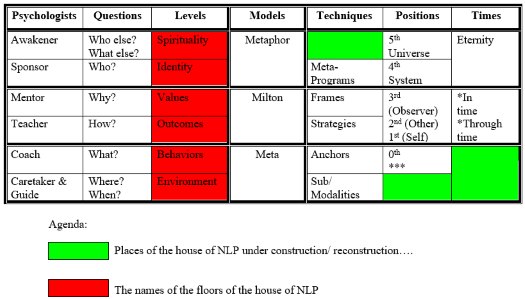
All six floors of the house of NLP are well documented. These documents, that are the treasure of palace-cottage’s library, should be researched slowly and carefully in order to grasp any important detail.
Below I’ll present only the palace-cottage’s cellar and attic. These two elements give centrality and verticality to the house of NLP.
The cellar – the “environment” level
One of the interesting things about the cellar is that it, at its origins, was not a cellar. In fact, long ago, it was a house and the passage of time, and the subsequent constructions made over, imposed that this house to become a cellar… in the present times. However, the inhabitants of the house are busily building it, so it is uncertain what this cellar will be and become in the near future…
Therefore, at the beginning, the cellar was a house. And this house was described from three different perspectives by Anthony Robbins:
“One house is located on a quiet, peaceful street. Almost any time of day you can walk out and hear the birds. It has a storybook interior that speaks so eloquently, it’s hard not to ask yourself how anyone could pass it by. Around twilight, you wander out to the garden just to listen to the birds, the breeze rustling through the branches, and the sound of the wind chimes on the front porch.
Another house is amazingly picturesque. You get excited just looking at it. It’s visually stunning, from the long white porch out front to the beautifully detailed wainscoting on the peach-colored walls. There are windows everywhere, so it has beautiful light at almost any time of the day. There’s so much to look at, from its winding stairways to its elegant carved oak doors, you could spend a day just exploring every nook and cranny, finding out what new things there are to see.
The third house is harder to describe. You have to go and experience it yourself; you just have to feel it. Its construction is solid and reassuring. Its rooms have a distinctive warmth. In a totally undefinable way, it touches something very fundamental in you. It’s almost nurturing. You feel like sitting in a corner and soaking up whatever vapors are making you feel so serene.
In all three cases, I’m talking about the same house.” (1986: 239-240)
In fact, Anthony Robbins present three modalities of NLP: the auditory (or the first description of the house), the visual (that is: the second description of the house) and the kinesthetic (namely the third description of the house). These three modalities – in addition with the taste and the smell – are important elements of what today is call “the environment” – or the NLP’s cellar.
The attic – the “identity” level, and the “spirituality” level
The attic assures the unity of the house, of the palace-cottage. Although it is certain that the cellar was first built, then the intermediary floors, and only at the end the attic, it is even more certain that some of the materials used to build the attic are older than the materials used to build the cellar. This is a consequence of the fact that the house of NLP was undergoing a process of construction and reconstruction.
Without specifying how much is spirituality, and how much is identity (those two being two different levels), Penny Tompkins and James Lawley outline two sections of the attic….:
“The Gallery holds over 200 items ranging from single-page reports on how someone is using Clean Language to multi-part treaties on emotion and cognition. Something for everyone we hope.
As you’ll see from the floor plan, The Gallery has two floors. The ground floor has six rooms. Four are devoted the core components of the work: Clean Language, Metaphor, Clean Space & Emergence, and Modelling. The other rooms include Symbolic Modelling, James Lawley and my way of integrating the components, and The Developing Group, a record of our exploration of new ideas and developments to the model since 2001.
Upstairs you’ll find five more rooms. These are dedicated to things further afield. First there are the growing number of Applications of this fascinating work. Then there’s the Related Material room which contains transcripts, case studies, personal stories, interviews and in particular a section devoted to the originator of the field David Grove.” www.cleanlanguage.co.uk
Clearly, both at the spirituality level and at the identity level, the metaphor – the concept and its applications – is fully used. However the two floors of the metaphor, presented by Tompkins and Lawley, are an integral part of both the identity level and the level of spirituality, without a clear indication of the percentage that the metaphor covers these two levels.
***
As a footnote, in the same way that someone could says that the levels of identity and spirituality are parts of the attic, in the same way the same person could add that the levels of environment and behavior are two parts of the cellar. Of course, the person would be wise to specify that both identity and behavior are levels pertaining to the human being – on the one hand, while both spirituality and environment are levels pertaining to something different to the human being – on the other hand.
There is vast literature on the six levels of the house of NLP. Most of these documents are written by Robert Dilts, starting from 1990 (Dilts 1990 a, 1990 b, 1994, 2003, 2009, 2010 and 2014); though – it would seem – the project for these levels, for these floors, is much older, dating at leas 10 years before those writings.
At a careful research, in the documents written by Robert Dilts, someone could find little incongruences.
For instance, according to some of them, the NLP house has 5 floors that are built like a totem. In other words, they are designed as being laid down one above the others in the shape of a perpendicular line (Dilts, 1990)
However, according to other documents, the same house has 6 floors concatenated like Russian dolls, or Matryoshka. These floors have the shape, not of a line, but of a pyramid (Dilts, 1994)
(In fact, there are two pyramids: the first, laid on its base, consists of 6 levels; while the second, laid on it apex, has many levels that have not yet been built. So, the floors of the second pyramid exist only in plans, only as a project…)
So, beside their shapes (totem versus Matryoshka), the second version of the house differs from the first one for it has an additional level called “spirituality”…
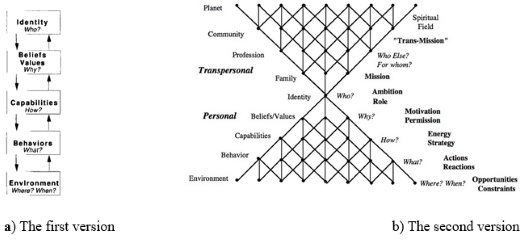
As I said, there is a vast network of labyrinths that starts from the cellar of the palace-cottage, reaching any place in the city and deep in the woods on the outskirts. These labyrinths, although made of stone, have a life of their own, being used by the inhabitants of the palace-cottage.
Below, I’ll explore some of these labyrinths, especially those which were not documented in the great library of NLP house… yet. However, this is not an exhaustive exploration…
Wilber – Great Nest of Being
Ken Wilber (1998, 2000 a, and 2000 b) presents a summary of the world’s great wisdom traditions. These traditions maintain the followings:
- The presence of levels: there are different levels or dimensions of existence, stretching from matter, to body, to mind, to soul, to spirit; these levels, or dimensions, appeared in Hindu and Buddhist notions of the three great states of being: gross (matter and body), subtle (mind and soul), and causal (spirit) – just to mention another tradition; each level of reality has a branch of knowledge: physics studies matter; biology studies bodies, psychology and philosophy address the mind, theology studies the soul, and mysticism studies the spirit.
- The higher levels and the lower levels: there is a simple rule for establishing higher levels and lower levels in any sequence: if you destroy, in your imagination, any particular type of level, then all of the higher levels will also be destroyed, but none of the lower levels;
- The depth and the span of the levels: greater span means lesser depth, and greater depth means lesser span; the reason is: because the higher i) transcends and ii) includes the lower, there will always be less of the higher and more of the lower;
- To transcend and to include: each higher level includes the lower levels, and – more than that – possesses emergent qualities not found on the lower levels; so, each level of reality has a different architecture;
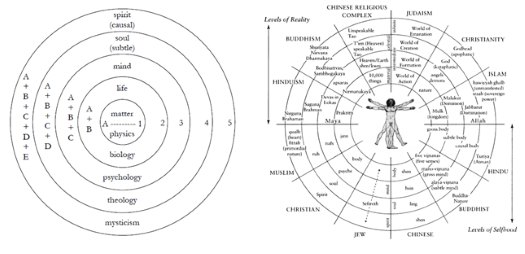
Koestler – Holon & Holarchy
Arthur Koestler explains the notions of “holon” and “holarchy” starting from a story told by a designer of logic computer and chess-playing machines: Herbert Simon – namely the story of “the two Swiss watchmakers”. In his 1967 book he explores the notion of “holon”, and later, in 1978, in another book, he explores also the notion of “holarchy”.
- The two Swiss watchmakers – Bios & Mekhos: the story of the two Swiss watchmakers is a metaphor. Primo, Bios was making watches by constructing subassemblies of ten components: ten subassemblies fit into a subsystem; ten subsystems constitute the watch. Each time he was disturbed in his work he had to start again the last assembly. Secundo, Mekhos was making watches bit by bit, like a mosaic floor. Each time he was disturbed in his work he had to start again from the beginning. In fact, Bios’ way of making watches is a metaphorical illustration of what to be explained as “holon” and “holarchy”;
- The part & the whole: the part means something incomplete, while the whole is considered something containing parts. However, parts and wholes don’t exist independently, but only in relation with each others: each whole is a part for a superior whole, as each part is a whole for an inferior part. This unity of part/whole was labeled the “holon”, from the Greek “holos” = whole, and from the suffix “on” = part;
- The hierarchy: the holons are arranged into a hierarchy, one above others. And this hierarchy was labeled by Koestler, “holarchy”= a hierarchy of holons;
- The Janus principle: the Janus is the Roman god with two faces looking at opposite directions. In essence, the Janus principle says that the face turned downward the hierarchy is the face of the whole; while the face turned upward the hierarchy is the face of the part;
- The depth & the span: the number of levels which a hierarchy comprises is called its “depth” (so, the depth is a vertical vision); while the number of elements on a single level is called the “span” of the hierarchy (and the span is an horizontal perspective)
Below are some examples of holarchies:
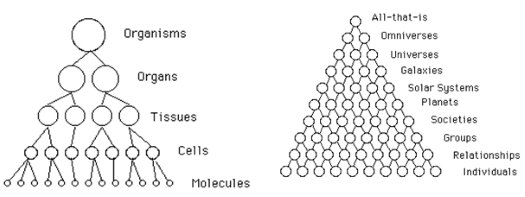
Schumacher – Levels of Being
Schumacher (1986) labeled The Chain of Being as The Levels of Being, levels of being characterized by the following elements:
- The four levels: mineral, plant, animal and human; these levels can be seen as extending “downwards” from the highest to the lowest; or they can be seen as extending “upwards” from the lowest to the highest; we are able to destroy them, but unable to create them;
- The labels: “m” is labeled matter; “x” is labeled life force; “y” is labeled “consciousness”; and “z” is labeled self-awareness; these are only labels, and not the descriptions of the four levels; x, y, z are “invisible”, while m is “visible”: only “m” is directly accessible to objective, scientific, observation by means of our five senses; the other three are known to us from our inner experience;
- The ontological discontinuity: the minerals have “m”; the plants have “m+x”; the animals have “m+x+y”; and – finally – the men have “m+x+y+z”; these four elements form a sequence of increasing rarity and increasing vulnerability (“m” is the most common and the most durable, while “m+x+y+z” is the most rare and the most vulnerable);
- Higher levels and lower levels: higher always means: “greater interiority, greater depth and a greater capacity for intimacy”; while lower always means: “greater exteriority, greater span and greater anonymity”; this means that: i) the higher possesses the powers of the lower; and ii) the higher possesses the power over the lover; the higher exceeds the lower and, moreover, it organizes the lower;

Lovejoy – Great Chain of Being
The book “The Great Chain of Being” contains 11 lectures delivered by Arthur Lovejoy in the second half of the academic year 1932-1933 under the William James foundation of Harvard University. The thread of the book is woven around four concepts: a) The Chain of Being, and b) Its main characteristics: plenitude, continuity, and gradation.
- Plenitude (exhaustivity): this principle is presented in the second chapter when Lovejoy talks about Plato, and it means that this ladder is complete: no element was left outside;
- Continuity and gradation (hierarchy): Aristotle presented first these two principles – continuity (all things constitute linear series) and hierarchy (according to the degree of perfection);
- The Chain of Being: after he presented the genesis of the three principles, Lovejoy stops for a moment to the systematizer of the elements of The Chain of Being – namely Plotinus. In fact, the whole book is about some variations of one theme: the ontology that is continuous, hierarchical and exhaustive. And this unique theme can be resumed as below…

Aristotle – Scara Naturae
According to David Ross, although Aristotle has not conducted a systematic classification of existence, the fragments of such classification can be foreseen in at least two of his works: “Historia Animalium” and “De Generatione Animalium”.
- Sanguineous & Bloodless: Aristotle divided the beings between “sanguineous” and “bloodless” (by “bloodless” he meant the absence of red blood and the presence of analogous liquids). In modern times, this classification is the division between the vertebrates and invertebrates;
- Reproduction: also, Aristotle classified the beings by how they reproduce. This could happen in several ways: by birth, by eggs, by worms, by slime, budding or spontaneous generation;
- So, the classification could be made according two axes: how the creatures live, and how the creature reproduce:
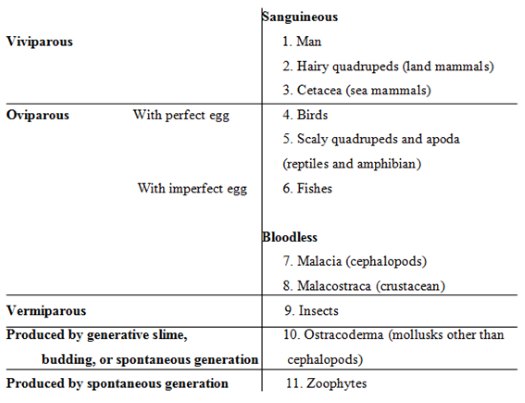
Burke – Pentad/ Hexad
Kenneth Burke (1945, 1968) created a method for analyzing a situation like a text, or a series of articles. At first, Burke identified five “points”, and called the method “the pentad”: the act, the scene, the agent, the agency, and the purpose (1945). Later, he added a sixth “point”, changing the name of the method in “the hexad”: the attitude (1968).
It is known that Burke had five children and he associated them with the five terms of his earlier formulation of the method. He also said that his method has five terms as the fingers on a hand. However, later, when he added the sixth term, he changed his mind studying more closely the agency, the act and the agent, and noticing that inside them is trapped the attitude term.
Parenthetically, the five (six?) terms are in fact an adjustment of the seven (!) questions used, since Antiquity, in rhetoric: “who”, “what”, “where”, “when”, “why”, “how”, and “by what means” (or, in Latin, in a random order: “quis? quid? ubi? quibus auxillis? cur? quo modo? quando?”)…
In short, these are the six elements of his method:
- The scene = the context = the time and the space
- The act = the behavior
- The agent = the person = the man or the woman
- The agency = the mean/ the means = the resources
- The purpose = the end/ the ends = the goal/ the goals
- The attitude = the world view
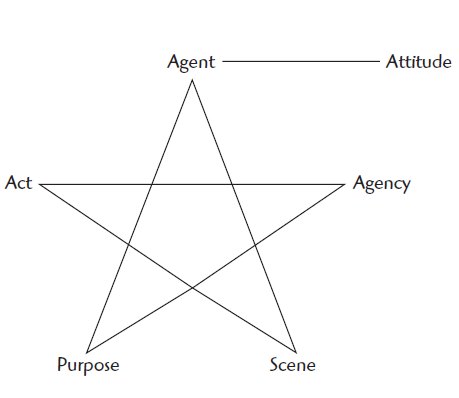
Kipling – Six Serving Honest Men
Rudyard Kipling, in “The Elephant’s Child” story, talks about six questions, fundamental for any knowledge process: “what?”, “why?”, “when?”, “how?”, “where?” and “who?”. Of course, two other questions can be added to these questions: “who else?”, and “what else?”…
I KEEP six honest serving-men
(They taught me all I knew);
Their names are What and Why and When
And How and Where and Who.
I send them over land and sea,
I send them east and west;
But after they have worked for me,
I give them all a rest.
I let them rest from nine till five,
For I am busy then,
As well as breakfast, lunch, and tea,
For they are hungry men.
But different folk have different views;
I know a person small –
She keeps ten million serving-men,
Who get no rest at all!
She sends’em abroad on her own affairs,
From the second she opens her eyes –
One million Hows, two million Wheres,
And seven million Whys!
(www.kiplingsociety.co.uk/poems_serving.htm):
Graves –Levels of Existence
Clare Graves (1966, 1970, 1974 and 1981) presented a hierarchy of values starting from the following three elements:
- Two spirals: the gravesian hierarchy is composed of two sets of determining forces: a) the environment (or “the existential problems of living”) and b) the organism (or “the neuropsychological equipment for living”);
- Those are emergent: any change in the organism has a parallel in the environmental changes;
- Those are cyclical: the change is either toward lower levels in the hierarchy – when the organism doesn’t solve the problems posed by the environment; or toward higher levels in the hierarchy – when environmental issues are efficiently solved by the organism;
- Therefore, the Grave’s model contains 8 levels – six belonging to the subsistence, and two belonging to the being – from old and simple, toward new and complex:
Levels of subsistence:
- AN: Automatic: express self as if just another animal according to the dictates of one’s imperative periodic physiological needs
- BO: Tribalistic: sacrificie one’s desires to the way of one’s elders
- CP: Egocentric existential state: express self but to hell with others, lest one suffer the torment of unbearable shame
- DQ: Saintly: sacrifice self now to receive reward later
- ER: Materialistic: express self for what self desires, but in a fashion calculated not to bring down the wrath of others
- FS: Sociocentric: sacrifice now in order for all to get now
Levels of being:
- GT: Cognitive: express self for what self desires but never at the expense of others, and in a manner that all life, not just my life, will profit
- HU: Experientialistic: the self focus holistically on the well being of all entities, being comfortable with many paths to knowing
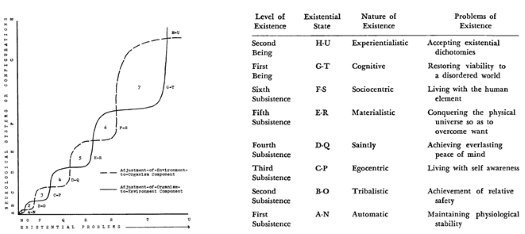
Maslow – Hierarchy of Needs
Abraham Maslow (1943 a, 1943 b, and 1970) talk about the hierarchy of needs according to two axes: a) the body which organizes some hierarchical needs, and ii) the environment that provides the means to satisfy these needs.
Moreover, Maslow presented 16 assumptions laid at the foundation of the ranking of the five types of needs. From these, the following are more important:
- Needs = desires = goals: the study of motivation must be in part the study of the ultimate human goals or desires or needs;
- Relationships of motivations: as one desire is satisfied, another pops up to take its place; however, this statement might give the false impression that a need must be satisfied 100 percent before the next need emerges; a more realistic description of the hierarchy would be in terms of decreasing percentages of satisfaction as we go up the hierarchy of needs;
- The role of gratified needs: our needs usually emerge only when more lower needs have been gratified; gratification has an important role in motivation theory;
- Human motivation and animal motivation: it is a truism to say that a white rat is not a human being; it is no more necessary to study animals before one can study man, than it is to study mathematics before one can study geology or psychology or biology;
- Cultural specificity and cultural generality: this classification of needs is an attempt to account for the unity behind the diversity of cultures.
In short, the levels of the hierarchy of needs are:
- Self-actualization
- Esteem
- Love and Belonging
- Safety
- Physiological
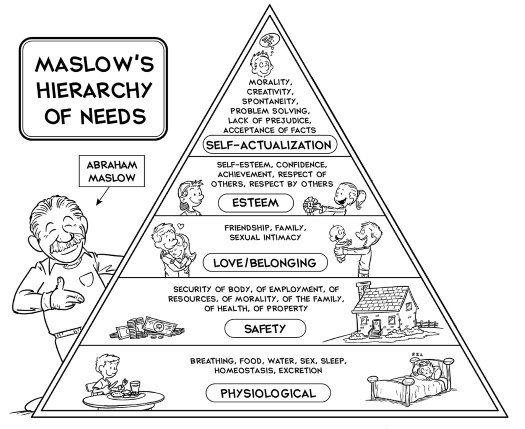
The NLP is a house. It has a cellar – called “Neuro”, and an attic – named “Linguistic”. To go upstairs means to reach the skies of the ideas. While, to go down to the cellar is to take in possession all the secrets of the earths. In short, only some people have the honor to explore these levels, looking for treasures (and their dragons) that cannot be found by the common-sense beings. These special people could be called “Dreamers”, “Poets”, or “Teachers”… even if they like to call themselves “Programmers”. For them, the skies and the earths, somewhere on the line of the horizon, are just one!
The intermediaries floors of the NLP house are engaged in “foreign” commerce: here, everyone trade some objects they don’t deeply know, even if they think so. However, at these floors, the doors are thrown open. And you can hear the cheerful hum of voices, and the children laughing and screaming through the halls. You don’t have to be a dreamer, a programmer, a poet, or a teacher, to live a happy and abundant life!
At every floor, there are wardrobes, drawers and chests. For the secrets. Even if the greatest secret of all is that there is no secret what so ever. It is just trust, and intuition, and common-sense, and may other things…
This is NLP. This is the house of NLP. The palace-cottage of NLP…
http://www.clarewgraves.com
http://www.cleanlanguage.co.uk
http://www.kiplingsociety.co.uk
http://www.nlpu.com
Bachelard, Gaston (2014): “The poetics of space”, Penguin Books
Burke, Kenneth (1945): “A grammar of motives”, Prentice Hall
Burke, Kenneth (1968): “Dramatism” in David Sills (ed.): “The international encyclopedia of the social sciences”, Macmillan/ Free Press, pp. 3829-3836
Dilts, Robert (1990 a): “Changing Belief Systems with NLP”, Meta Publications
Dilts, Robert; Tim Hallbom & Suzi Smith (1990 b): “Beliefs. Pathways to Health & Well-being”, Metamorphous Press
Dilts, Robert (1994): “Strategies of Genius”, volume I, Meta Publications
Dilts, Robert (2003): “From Coach to Awakener”, Meta Publications
Dilts, Robert; Judith DeLozier & Deborah Bacon Dilts (2010): “NLP II. The Next Generation. Enriching the Study of the Structure of Subjective Experience”, Meta Publications
Dilts, Robert (2014): “A Brief History of Logical Levels”, http://www.nlpu.com/Articles/LevelsSummary.htm
Gilligan, Stephen & Robert Dilts (2009): “The Hero’s Journey. A voyage of self-discovery”, Crown House Publishing Limited
Graves, Clare (1966): “The deterioration of work standards”, Harvard Business Review, vol. 22, no. 5, pp. 117-128
Graves, Clare (1970): “Levels of existence: an open system theory of values”, Journal of Humanistic Psychology, vol. 10, no. 2, pp. 131-155
Graves, Clare (1974): “Human nature prepares for a momentous leap”, The Futurist, april, pp. 72-87
Graves, Clare (1981): “The emergent, cyclical, double-helix model of the adult human biopsychosocial systems” http://www.clarewgraves.com/articles_content/1981_handout/1981_summary.pdf
Hayakawa, Samuel Ichiye (1947): “Language in action. A guide to accurate thinking, reading and writing”, Harcourt, Brace and Company
Koestler, Arthur (1967): “The ghost in the machine”, Random House
Koestler, Arthur (1978): “Janus. A summing up”, Vintage Books, a division of Random House
Lovejoy, Arthur (1936): “The great chain of being. A study of the history of an idea”, Harvard University Press
Maslow, Abraham (1943 a): “A preface to motivation theory”, Psychosomatic Medicine, vol. 5, no. 1, pp. 85-92
Maslow, Abraham (1943 b): “A theory of human motivation”, Psychological Review, vol. 5, no. 4, pp. 370-396
Maslow, Abraham (1970): “Motivation and personality”, Harper & Row Publishers
Robbins, Anthony (1986): “Unlimited power. The new science of personal achievement”, Free Press
Ross, David (1995): “Aristotle”, Routledge
Schumacher, Ernst Friedrich (1986): “A guide for the perplexed”, Abacus
Wilber, Ken (1998): “The marriage of sense and soul: integrating science and religion”, Random House
Wilber, Ken (2000 a): “A brief history of everything”, Shambhala
Wilber, Ken (2000 b): “One taste. Daily reflections on integral spirituality”, Shambhala

Please check the NLP & Coaching course at Pilgrims website.


|